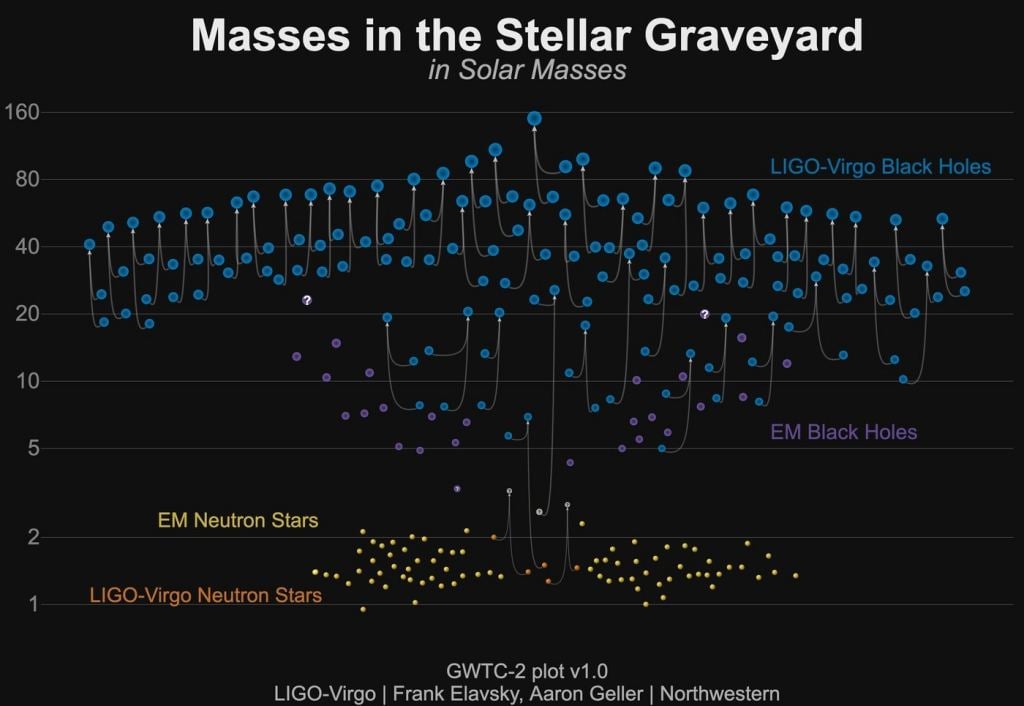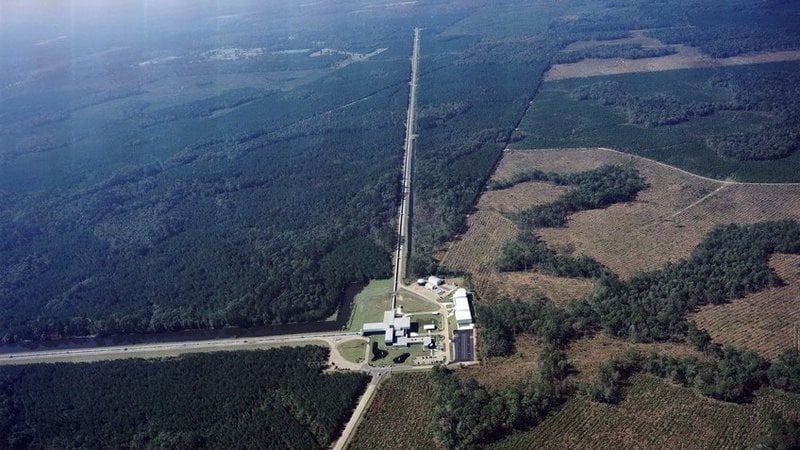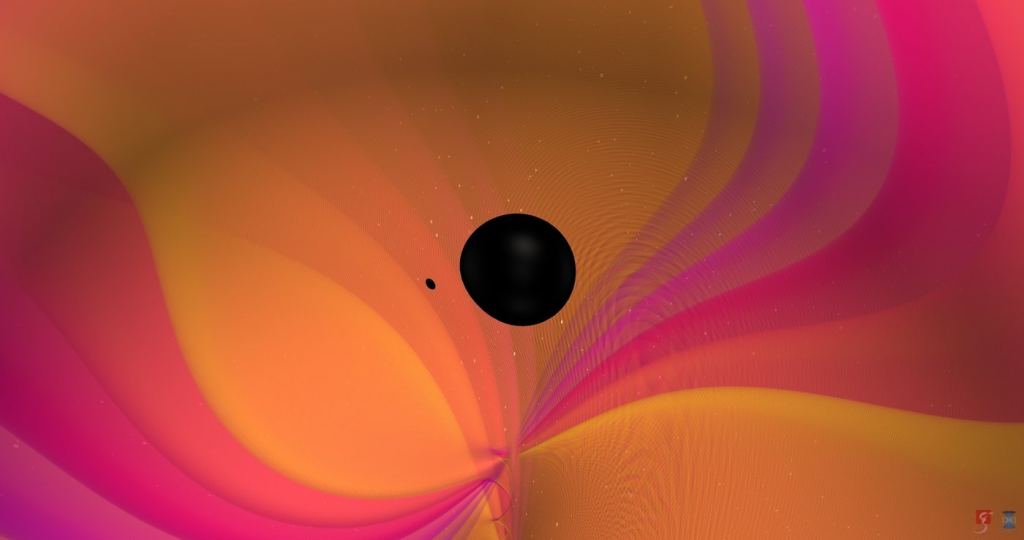The Theory of Relativity predicted the existence of black holes and neutron stars. Einstein gets the credit for the theory because of his paper published in 1915, even though other scientists' work helped it along. But regardless of the minds behind it, the theory predicted black holes, neutron stars, and the gravitational waves from their mergers.
It took about one hundred years, but scientists finally observed these mergers and their gravitational waves in 2015. Since then, the LIGO/Virgo collaboration has detected many of them. The collaboration has released a new catalogue of discoveries, along with a new infographic. The new infographic displays the black holes, neutron stars, mergers, and the other uncertain compact objects behind some of them.
LIGO stands for Laser Interferometer Gravitational-Wave Observatory. LIGO is actually two facilities in the US, both built and operated by Caltech and MIT. LIGO's collaborative partner is Virgo, an interferometer located in Italy. When they were observing between 2002 to 2010, they detected no gravitational waves and no mergers. Eventually, the facilities were upgraded, and in 2015 they detected their first merger.
That event was called GW150914 and resulted from a merger between a 36 stellar-mass black hole and a 29 stellar-mass black hole. That was a big deal. Three scientists behind the first observation were awarded a Nobel Prize, and the observation promised to open a whole new window into astronomy and cosmology. Now, the LIGO/Virgo collaboration detects a merger and gravitational waves about once every five days.
The infographic accompanies the new catalogue of gravitational waves and mergers published by LIGO/Virgo. The catalogue is called the GWTC-2, or Gravitational-Wave Transient Catalog-2. While the previous catalogue contained only 11 signals, this new one contains 50.
“We’re getting a richer picture of the population of gravitational-wave sources."Frank Ohme, Leader, Independent Max Planck Research Group at AEI Hannover
The signals come from all combinations of mergers between black holes and neutron stars.
The new catalogue contains some surprises. A pair of the detections were from the mergers of low-mass objects.
"One of our new discoveries, GW190426_152155, could be a merger of a black hole of around six solar masses with a neutron star. Unfortunately the signal is rather faint, so we cannot be entirely sure," explains Serguei Ossokine, a senior scientist at AEI Potsdam. "GW190924_021846 certainly is from the merger of the two lightest black holes we've seen so far. One had the mass of 6 Suns, the other that of 9 Suns. There are signals from mergers with less massive objects like GW190814 but we don't know for sure whether these are black holes."
The new detections in the catalogue result from improvements in the LIGO/Virgo collaboration. Raw data processing has been improved, as well as how glitches or disturbances are dealt with. A press release says that these improvements will allow LIGO/Virgo to "listen deeper into the cosmos than ever before."
"One key to finding a new gravitational-wave signal about once every five days over six months were the upgrades and improvements of the two LIGO detectors and the Virgo detector," says Karsten Danzmann, director at the Max Planck Institute for Gravitational Physics (Albert Einstein Institute; AEI) and director of the Institute for Gravitational Physics at Leibniz University Hannover. "Important roles played, for example, by the high-power lasers developed at AEI Hannover, new mirrors, and the reduction of background noise sources. This increased the volume in which our detectors could pick up the signal from, say, merging neutron stars by a factor of four!"
On the surface of it, each of these events can appear similar. They're all the result of mergers of black holes and/or neutron stars. But according to Frank Ohme, leader of an Independent Max Planck Research Group at AEI Hannover, observations are revealing more and more detail.
"When you look at the catalogue, there's one thing all events have in common: They come from mergers of compact objects such as black holes or neutron stars. But if you look more closely, they all are quite different," said Ohme. "We're getting a richer picture of the population of gravitational-wave sources. The masses of these objects span a very wide mass range from about that of our Sun to more than 90 times that, some of them are closer to Earth, some of them are very far away."
Researchers with LIGO/Virgo have also published four papers on their results. All three are up at arxiv.org, a pre-print server, and none have been peer-reviewed yet.
One of the highlights in the catalogue is GW190521, which is the most massive binary black hole merger with a total mass of 150 Suns and the first observation of the birth of an intermediate-mass black hole. Another is GW190425, which is most likely the second observation of a binary neutron star merger.
As time has passed, technology has produced ways of testing the predictive accuracy of Einstein's theories. One of the new papers addresses how well the LIGO/Virgo detections have agreed with general relativity. It's titled " Tests of General Relativity with the Compact Binary Signals from the LIGO-Virgo Catalog GWTC-2." Einstein's theory held up well—again—and according to a press release, the study found "no evidence for new physics beyond this theory."
Another paper uses mergers and gravitational waves to come up with a new measurement for the Hubble constant. Its title is " A gravitational-wave measurement of the Hubble constant following the second observing run of Advanced LIGO and Virgo." Rather than using standard candles, the paper makes use of "standard-sirens." Standard siren refers to how the distance to a merger event is encoded in the gravitational waves that result from the event.
This new catalogue covers the first half of observing run three (O3), which ran from 1 November 2019 to 27 March 2020. LIGO/Virgo researchers have issued alerts for another 23 events in O3b, the second half of observing run three. But they're only possible gravitational waves and haven't been confirmed yet. After a more detailed analysis, some of them may be published.
 Universe Today
Universe Today



